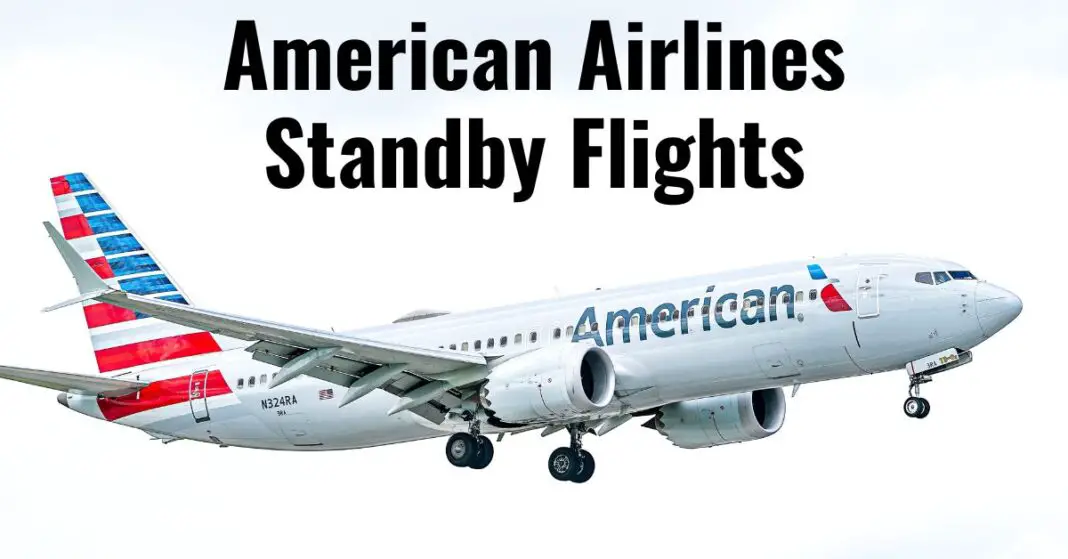Navigating the ins and outs of airline travel can be a bit like solving a puzzle, and understanding how standby works with American Airlines is a crucial piece.
Whether you’re a seasoned traveler or a first-timer, this blog will break down the basics of American Airlines Standby, making your journey through the skies a smoother experience. Let’s dive into the details and uncover the secrets behind this travel option.
Table of Contents
Understanding American Airlines Standby Flights
Standby flights with American Airlines present the opportunity to craft a flexible travel plan that pivots effortlessly with the demands of doing business in the 21st century.
A standby flight happens when a passenger travels on a flight they were not initially booked on, due to it being earlier or later than their original flight. This option allows them to accommodate last-minute changes in their schedules.
This service is the travel industry’s response to innovative market trends and the evolving requirements of the modern businessperson. With American Airlines, you have a chance to access this untapped resource to manifest a productive and seamless involvement.
Specifically, American Airlines offers two types of standby flights. One, the Same-Day Flight Change, allows holders of certain tickets to change to an earlier or later flight on their anticipated day of travel. Two, the Same-Day Standby, allows selected ticket holders to request an earlier flight.
These options transport the concept of flying to a whole new altitude of accessibility and convenience. It is a reminder that, even in the thriving world of business travel, adaptability and savviness can inspire impressive innovation in service delivery.
To embark on this thrilling journey, make sure the alternate flight you desire is within 24 hours of your originally booked flight. Passengers who benefit from this service typically fall under three categories: those with elite status, premium cabin customers, and others who pay the fee.
Standby Process and Protocol
- Choose the Ideal Flight: The first step begins with selecting your optimal flight, keeping in mind the imponderables that might necessitate shifting to standby mode. Air travel is dynamic, and your airline choice must be as responsive as you are. American Airlines offers a plethora of options to cater to your unique business requirements. Make sure you’ve made the best choice to fit your schedule.
- Navigate the American Airlines Website or Mobile App: The airline’s digital platforms pack a wealth of resources to facilitate standby booking. The website or mobile application provides easy-to-understand prompts to guide you towards the ‘Manage Trips/Check-in’ page where you can view your flights.
- Request Standby Status: Under your flight details, you’ll see an option to view available standby flights. To request this status, click on this option and follow the instructions provided. Your standby request would be placed in a queue, and the system automatically ranks standby requests based on American Airlines’ priority rules.
- Check the Standby List: You can see where you stand in the queue by checking the display screens at the airport or by logging on to the website or mobile application. Don’t forget – visibility is power! Being in the know can enhance your agility in planning destination arrivals or critical meeting schedules.
- Arrive Early and Verify Standby Status: Time is the fertile soil where opportunities grow. Arrive early at the airport and verify your standby status with a representative at the gate. The success of transitioning to standby mode lies in striking the perfect balance between swiftness and patience.
- Embrace the Possibilities: Filling every moment with purpose is the secret to making life more meaningful and business more productive. Detained by a meeting that runs late or graced with an unexpected chance to return earlier? No problem! Standby flights are your secret weapon against the uncertainties of business travel.
Getting on the American Airlines standby list can open the doorway to flexibility, timely adaptation, and mission efficiency. In the ever-changing landscape of the business world, it provides a strategic tool that matches the speed of innovation with the pace of action.
Use it to take the business travel experience to new heights, where each flight helps shape the future of business. Leverage the standby flight strategy to be always competitive, flexible, and ahead.
Standby Policies and Fee Structures
When it comes to determining the policies and fees associated with standby flights on American Airlines, there are several critical areas to understand. The evolution of business and air travel takes us into the nuances of American Airlines standby policies to enlighten frequent flyers or first-timers who aim to leverage this service.
First, recognize an important point: the current situation of automatic standby. As per the airline’s approach, anyone who opts for the same-day flight change would automatically be considered for standby if the requested flight becomes unavailable or fully booked. Distressing it might sound, but who better than a discerning entrepreneur to spin the wheel of contingency in their favor?
Secondly, let’s delve into the financial side. At American Airlines, there is a clear distinction in their standalone Same-Day Travel policy. This means business-minded individuals like us can switch to a flight leaving on the same day as the ticketed flight for a flat fee of $75, independent of the difference in ticket price. This offers a cost-effective solution for those spontaneous business meetings or unpredicted shifts in strategy requiring your in-person attendance.
Moreover, elite AAdvantage members and customers who purchase a first class, business class, unrestricted economy class, or a full-fare ticket are exempt from this change fee, making it an incredibly shrewd investment for our frequent travel and making full use of the premium benefits attached.
When it comes to the operational side of things, standout tactics are essential to navigate the process of flying standby with ease. Once you decide on catching a standby flight, ensure the request is made at least 24 hours before departure. It’s about seizing the opportunity at the right time! What’s more, the use of American Airlines’ platform to check the real-time status of standby lists leads to strategic decisions that align with your travel goals.
Keep alert and arrive early at the airport to verify your standby status. The trick here is pure elementary- the early bird gets the worm! The process includes verifying your standby position and receiving a boarding pass if a seat becomes available.
Bearing in mind the uncertainties, it’s key to remember that standby flights may not always guarantee a seat. But as traditional as it may seem, it’s just taking calculated risks for a grand return of flying at reduced costs or earlier times.
How do I check my standby list on American Airlines?
To check your standby position on American Airlines, you have two options: at the airport or online.
At the airport:
- Gate information displays: Add yourself to the standby list at the gate and check your position on the electronic displays nearby. These displays update regularly, listing passengers waiting for standby seats by fare class and upgrade priority.
- Gate agent: Approach the gate agent who can access the standby list and inform you of your current position or any updates on available seats.
Online:
- American Airlines app: Twelve hours before your scheduled departure, a “Waitlist” button may appear on the app. Click it to see the upgrade list, then choose “Standby” from the drop-down menu to view the standby list and your position.
- American Airlines website: Unfortunately, the online version of the American Airlines website does not currently provide direct access to the standby list for non-elite members.
What are the chances of getting on a standby flight with American Airlines?
The likelihood of securing a standby flight with American Airlines is uncertain and depends on various factors:
Flight Factors:
- Day and Time: Weekends and peak travel times experience high demand, reducing the chances of open seats. Early-morning and late-night flights may also have limited availability.
- Route and Destination: Popular and business routes tend to have fewer open seats than less frequented ones.
- Flight Load: Check online for the flight’s booking status, avoiding those labeled “limited” or “no availability.”
Your Situation:
- Fare Class: Higher fare classes like First and Business typically offer more standby availability than Economy.
- AAdvantage Status: Elite members (e.g., Platinum, Executive Platinum) receive priority on the standby list.
- Reason for Standby: Traveling on a confirmed ticket takes precedence over using an upgrade certificate.





